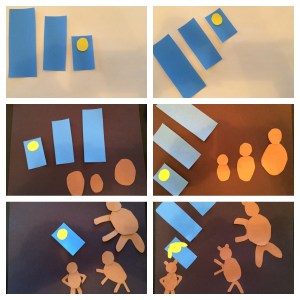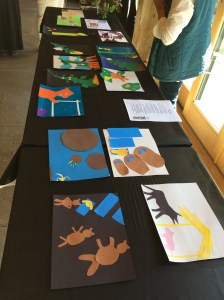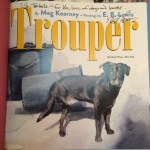I thought I knew a lot about picture books since I’ve been reading them aloud to students for over a decade. Then I attended a Highlights Foundation workshop, The Power of Picture Books, led in conjunction with the Eric Carle Museum of Picture Book Art from October 10 – 12th. After spending an intensive weekend learning from Rosemary Agoglia and Alison Green Myers I now know about picture books as an art form (not just as something to be read or examined for author’s craft). The workshop included two special guests (Leslie Barrett George and E.B. Lewis), learned about Visual Thinking Strategies, the Whole Book Approach, and the principles of picture book art. Here’s a peek at some of the things I learned:
Visual Thinking Strategies
I’ve seen Visual Thinking Strategies, or VTS, in action since many of the art museums I took my students when I taught in Manhattan employed them during our museum tours. However, I didn’t have a name for the way museum educators were engaging my students to talk about art.
Rosemary taught us about VTS, which are the strategies educators can employ to help children read pictures, on Saturday morning. Here’s an overview of VTS:
Visual Thinking Strategies (VTS) is a method initiated by teacher-facilitated discussions of art images and documented to have a cascading positive effect on both teachers and students. It is perhaps the simplest way in which teachers and schools can provide students with key behaviors sought by Common Core Standards: thinking skills that become habitual and transfer from lesson to lesson, oral and written language literacy, visual literacy, and collaborative interactions among peers (Retrieved on 10/14/14 from bit.ly/1r4Cdch).
 VTS is a method of facilitated discussion that requires training in order to be properly implemented. If you’re interested in learning more, start with Philip Yenawine’s book, Visual Thinking Strategies: Using Art to Deepen Learning Across School Disciplines. NOTE: VTS has a writing component, for which Rosemary rounded-up some links, which follow below. To learn more about VTS go to:
VTS is a method of facilitated discussion that requires training in order to be properly implemented. If you’re interested in learning more, start with Philip Yenawine’s book, Visual Thinking Strategies: Using Art to Deepen Learning Across School Disciplines. NOTE: VTS has a writing component, for which Rosemary rounded-up some links, which follow below. To learn more about VTS go to:
- Carpe Diem: Seizing the Common Core by Mary Franco and Kathleen Unrath
- Effective Means to Enhance Creative Writing Quality by Karen Randle
- Protocol for Writing Samples on the VTS website
- Pre- and post- writing samples on the VTS website
- Visual Thinking Strategies for Improved Comprehension by Kristina Robertson
- Visual Thinking Strategies: Writing About the Arts from the Columbia College of Chicago
Whole Book Approach
Using what we learned about VTS, we learned about the Whole Book Approach on Saturday afternoon.
The Whole Book Approach, developed at The Carle by former museum educator Megan Lambert, is designed to expand engagement with the picture book as an art form by creating opportunities to discuss how the pictures, design, and production elements of the picture book interact with the text to create an artistic whole. During a Whole Book Approach storytime, educators engage the listener in conversation in which the picture book serves as the provocation that engages them in careful observation, listening, and critical and creative thinking.
The Whole Book Approach shares some common ground with the American Library Association’s Dialogic Reading, a technique that has shown that pausing during read aloud times to talk about the story aids, rather than hinders, comprehension by providing time for reflection, clarification, and expansion. By expanding the “Hear and Say Reading” supported by Dialogic Reading strategies, the Whole Book Approach becomes the “See, Hear, and Say Reading,” in support of enhancing both visual as well as verbal literacy (Retrieved on 10/14/14 from http://bit.ly/1r5U8zg).
I immediately thought of the turn & talks, stop & thinks, and stop & jots, as well as the think-alouds, we encourage children to do as we’re reading. These things engage readers. Wouldn’t it be fantastic to read the whole book — words, pictures, and design — with children rather than reading to them? If you’re nodding, then the Whole Book Approach is for you!
To truly understand the Whole Book Approach, you need to learn about it from someone like Rosemary Agoglia or Megan Lambert. In an effort to share the basics with you, I created a short video.
Isabelle’s preschool teacher accepted my offer to volunteer some time to do some Whole Book Approach lessons with in her classroom in the next few weeks. I will write a follow-up post about my experience once I do a few Whole Book Approach read alouds.
As with any book you’re going to share with students, it’s important to be very familiar with the book. You can use a guiding students with a question like, “How can we make meaning out of the artistic and design choices in this book?” Using VTS, you can ask open-ended questions about the art and design of the book. Highlight just a few aspects of the book since you don’t want to get so engrossed in the design that you lose the storyline. Finally, listen to students’ responses and restate what they say so you’re honoring their contributions. (Remember: there’s no right or wrong answer when you’re asking students what they notice in a picture or about the design of a book since you’re asking them to state what makes them feel a particular way or notice something.)
The Principles
Author/illustrator Molly Bang published Picture This: How Pictures Work, a book that shares insights about what makes art resonate with picture book readers. I haven’t read Picture This, but Rosemary spent Sunday morning teaching us about how and why structural elements affect our emotions. (Click here to view a presentation by Molly Bang that explains her ten principles.)
Here are Bang’s principles as found in Picture This: How Pictures Work.
- Flat, horizontal shapes are perceived as more stable; it follows then that horizontal pictures are generally perceived as more stable, and small horizontal areas within a picture can be an “island of calm” (42).
- In contrast, vertical shapes seem more active, conveying a sense of strength and excitement (44).
- Diagonal shapes and lines suggest movement and tension. Most readers, at least in Western cultures, interpret diagonals from left to right, determining whether a slope ascends or descends by its direction (46-52).
- Objects in the upper half of a picture appear relatively more free and happier; they may also convey a sense of spirituality. Conversely, figures in the bottom half of a picture are more likely to appear sad or heavy, possibly under threat (54-56).
- The eye tends to go to the center of the page, “the point of greatest attraction”; illustrators can induce the reader to “explore” the picture by keeping the focus away from the center. Figures at the edge of the picture, breaking out of the frame, imply additional space and/or action outside of the picture and create added tension (62-66).
- Light-colored backgrounds feel “safer”; she relates this to human vision, which functions well during the daytime but is more limited at night (68).
- Pointed shapes are relatively frightening; rounded shapes and curves are comparatively comfortable (70).
- Larger objects tend to seem stronger; an object or a figure can be made more vulnerable by making it smaller (72).
- The human mind tends to associate objects by color more than by shape; other things being equal, similarly colored items will be seen as related to one another even if the picture contains other objects that are similar or identical in shape but colored differently (76).
- Contrasts (of color, or of light and dark) guide our ability to see images (80).
(Retrieved on 10/15/14 from http://bit.ly/1DdLEih.)
Once we learned about Bang’s principles, we had the chance to make some artwork of our own using the principles. We were given four colors of paper and were tasked with illustrating a moment in a fairy tale. It sounds easy, right? Not for me! With only 45 minutes to create a piece of visual art that reflected Bang’s principles, I got a taste of just how challenging it is to be an effective illustrator. Here’s a peek at some of my attempts to recreate a scene from “Goldilocks and the Three Bears”:

Once everyone completed the activity based on Bang’s principles, we discussed everyone’s artwork and the process:

Learn More/Attend

I attended the “Power of Picture Books” with Lynne Dorfman and Rose Cappelli. If you’re familiar with their professional books, you know they’re extremely knowledgeable about picture books. Like me, they also walked away from our weekend at Highlights knowing even more about the art and design of picture books.
If you have an interest in picture books, I highly recommend you attend an upcoming “Power of Picture Books” Workshop with Rosemary and Alison. Not only will you learn about all of the things mentioned above, but you’ll also make art with VTS, learn about storyboarding, and engage in book making. The dates have already been set for 2015. The workshop will be offered:
August 7th – 10th, 2015
October 9th – 12th, 2015
Another great part of the workshop are the special guests. We had two author/illustrators, Lindsay Barrett George and E.B. Lewis, provide us with informative presentations about themselves, their work, and picture book design in the evenings. In addition, they signed books for us!


Returning to Highlights, just seven weeks after my Unworkshop, was a treat. The grounds were even more beautiful since the leaves in NE Pennsylvania had already changed. The staff made sure the same chair was in my cabin so I could write in comfort despite my ongoing neck/shoulder/arm issues. The food was plentiful and delicious! The setting is tranquil, which means it’s easy to feel creative and write well when you’re there.



Thank you for this treasure-trove of information, Stacey! I’ve been interested in VTS for years, and this weekend sounds like an incredible opportunity to learn more.
LikeLike
You’d love this workshop, Catherine. If you can combine it with a day or two of an unworkshop so you have time to work on your writing, that’d be ideal.
LikeLike
I love VTS and have used it for years with students- both to look at art and to look at books. The questions are perfect to keep an open ended discussion going. I love the links you provided – It really helped me get a sense of the workshop and how the whole book idea blends with VTS.
Thanks for sharing!
LikeLike
That’s great, Joanne!
I’ve been trying to use some of the open-ended questions with my daughter when we look at art. Her answers have been interesting, to say the least. (She might be a little young for the work.)
LikeLike
Stacey, Sounds like a very enlightening weekend! The whole book approach you explained (thanks for the Stellar video, by the way. Very informative and helpful!) reminds me a bit of Steven Layne’s approach to book previewing. I read about it in his book Igniting a Passion for Reading. He has readers preview not only title, author, etc. but also the dedication, the flaps, the CIP page, the book jacket, the graphics…I did this with a group of 6th graders and was very surprised at how much I learned without even reading the book!
LikeLike
It really is incredible how much we can learn about the story from reading the pictures alone.
LikeLike
Reblogged this on Because of Him and commented:
For my teacher/writing friends.
LikeLike
I can’t wait to read this whole post!! I have taken my children to story time at the Carle and have not ignored the open/end pages of a picture book since 🙂
LikeLike
I would LOVE to live closer to the Carle. I’ve only been there once and thought it was incredible!
LikeLike
Wow! I learned so much from reading your post! Thank you for being so generous with the details and how you worked through the process. At some point, I would love to attend a workshop like this to make my picture book dreams a reality! Thank you so much for lifting the shade for us to view the window of your world.
LikeLike
You captured everything so wonderfully, Stacey. Thank you for helping me relive this enlightening workshop. The video you added will be so helpful to teachers (as well as bringing what I learned to the front of my brain!)
LikeLike
I’m glad it was useful, Rose. It wasn’t the world’s best video since I was limited to 15 second snippets on Steller. Hopefully it conveys the basics to those who are new to this work (like we were).
LikeLike